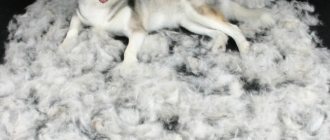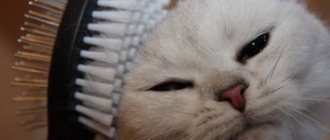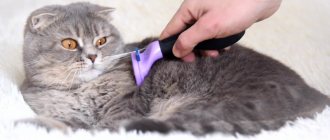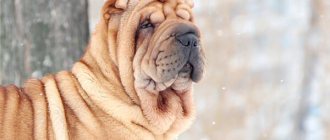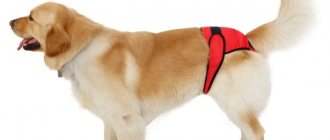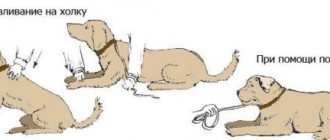The collar is called the main attribute of any dog equipment. Owners acquire them for both large and small pets. It’s incredible how many of them there are: everyday, decorative, in the form of a noose, strict; from various materials: leather, leatherette, metal, tarpaulin, etc.
How many collars the pet will have is up to the owner to decide. But an animal that is difficult to train must have a properly selected parforce, which must be used only during the period of training and education.
Choosing a collar is not an easy task; it should be approached with responsibility and seriousness. Especially when it comes to the planer. A strict collar for dogs (parfors) is a thing that is not uncommon in the arsenals of dog breeders. If owners of small dogs are not concerned about this issue, then breeders of large breeds should be puzzled by it. Choosing one is not so easy: parfors come in different types and even sizes - this is important, since it must fit correctly on the pet. Otherwise, injuries are possible or there will be no educational effect from it. In the photo you can see the varieties of this ammunition, and also see where it should be located. How to choose the right one, how to use it correctly, how much a dog planer costs - these are the main questions that should be answered before purchasing this equipment.
Main varieties
Wire
This type of parfors is made in the form of barbed wire, which, when tugged, digs into the skin and prevents incorrect and aggressive behavior of the four-legged friend.
wire
Lamellar
The product is made of many plates with central spines. Typically, such an accessory is purchased for small breeds.
lamellar
Rating of the best electric collars for dogs
The analysis of offers on the market was carried out taking into account customer reviews and reactions of training experts. The results of the device tests were particularly influential. When selecting suitable electric collars for dogs, each product was considered based on the following characteristics:
- Type – training or anti-bark;
- Focus on the breed and weight of the pet;
- Number of operating modes (usually there are three);
- Flexibility of impact settings;
- Equipment;
- Weight and dimensions;
- Design and color;
- Possibility of using the remote control with several devices;
- Range and sensitivity of the product to obstacles on the way;
- There are restrictions on the degree of sensitivity;
- Equipped with backlight;
- Materials from which the product is made;
- Charge replenishment speed and battery life;
- Belt length and the possibility of changing it.
When analyzing electric collars, attention was paid to their functionality, versatility, ease and safety of use. Last but not least was the price-quality ratio of the devices, the reputation of the manufacturers and their availability on the market.
The best dog clippers
Briefly about the purpose
Planer, or parfors, is equipment that is used for training large or hyperactive breeds of dogs . It allows you to train your pet and correct the aggressive behavior of complex breeds.
Did you know? Dog collars have been used since the ancient world. So, for example, in the 9th century. BC. The Chaldeans, who noticeably did not get along with Babylon, used swift and powerful dogs when attacking, wearing heavy metal collars with sharp curved knives.
These are metal links, inside of which there are spikes with rounded teeth, and they are located at an angle to minimize possible injury to the animal. Usually the end of the collar is not fastened, but passed through a ring.
When pulled, it tightens and the spikes impact the dog's neck. As soon as the animal takes the correct position, the tension weakens, the ends separate, and the discomfort disappears.
Video: features of using a strict collar in training When teaching a pet a certain command, for example: “near” or “fu,” the trainer/owner sharply pulls the leash, and the spikes with a certain force compress the animal’s neck, forcing it to obey.
The strength of the jerk and the frequency of use depend on the pet’s learning ability and are used at the discretion of the owner.
How to train a dog with a collar: basic rules
The rules of training are the same as for regular training, only one new element is added - the dog will be punished for inappropriate behavior. The trainer's main tools are an iron will and rewarding the animal for correctly following commands. The algorithm of actions is as follows:
- The owner or trainer gives the command.
- At the same time, he uses gestures to indicate to the dog what needs to be done (for example, “sit” - pressing on the sacrum, and “lying” - on the withers).
- If the pet at least approximately follows the command, he receives a reward - this way he will remember what to do.
- If the animal is stubborn, plays around, or refuses to exercise, the owner gives a short tug on the leash. The spikes imitate a bite on the neck - this is how dogs in a pack demonstrate that they are dissatisfied with the behavior of a relative.
Even the presence of a planer does not cancel the reward for the correct execution of commands. Gradually, the parfors is abandoned, replaced with a bridle, and then with an ordinary collar. Some dog trainers are against such harsh measures and believe that an associative connection between training and pain cannot be established.
Important! The goal of training is to ensure that the dog follows commands without parforce. If the pet is forced to obey only the fear of punishment, then serious mistakes have been made in training.
Tips for choosing
Size
Measure the volume of your pet's neck slightly below the auricle. Select the diameter of the parfors to be 5 cm larger than the girth.
Spikes length
The length of the spiked tips varies from 2 to 5 cm depending on weight, height and breed. For example, for thick-haired animals it is necessary to purchase a model with spikes of 4-5 cm, and for smooth-haired animals - no more than 2 cm. Currently, parfors with spurs with rubberized ends have become popular.
Material
The most common materials are stainless steel and galvanized metal. Often rubber, leather or thick fabric is added to it to soften the effect.
How to make it yourself
To make your own harness you will need the following things in specialized stores:
- material: synthetics, nylon, canvas, leather;
- all-metal rings - 4 pieces;
- felt or flannel to create a fabric lining;
- soft braid.
After purchasing the necessary materials, you need to measure the size of the husky: from the withers to the base of the tail, neck circumference, chest circumference at the widest point.
The accessory manufacturing process is divided into 3 stages:
- After obtaining the exact dimensions of the animal, you need to make a pattern based on these data, leaving 2-3 cm of nylon for the seams. If leather was chosen as the manufacturing material, then 4 cm should be left.
- Using the finished pattern, you need to make a fabric lining and connect them together using a sewing machine.
- Then you need to cut out the entire harness and stitch the braid on a machine. The outer straps must be stitched by hand and secured to the back using steel rings. Buckles with 3 holes can be attached to the strap, which will help adjust the fastening if your pet gains or loses weight.
With a warm lining your pet will feel more comfortable.
Types and models
Today, several types of strict collars are actively used by amateur dog breeders and dog handlers:
- wire models;
- plate type models;
- having long spikes for a long-haired animal;
- having short spines for a smooth-haired animal.
Among other things, studded parfors (in common parlance “strogach”) can be made of different types of metal with various types of coatings. Recently, a strict prong collar of the “German” type, which has a special fabric insert, has gained particular popularity.
This option is convenient to use when tied to a guard. Easy removal of the links allows the accessory to be used as a standard parforce with a fixed volume on the “dead ring”. The main advantage of such a collar is the presence of a detachable mechanism represented by a carabiner.
Help in choosing and how to use
A strict wide collar with spikes for dogs belongs to the category of special accessories, so you need to choose them very carefully. A distinctive design feature of any parfors is the presence of spikes , which cause discomfort to the dog during the process of tension.
During the selection and purchasing process, the table dimensions must be taken into account.
A prong collar must be used correctly. Otherwise, parfors thorns can cause severe stabbing pain to a pet, which can provoke:
- disorientation and long-lasting fear of the dog;
- addiction to constant pain and lack of the desired educational result;
- Inappropriate increase in the dog’s level of arousal and complete refusal to obey.
Proper use involves inflicting pain on the animal by pinching the dog's skin between the links. Such sensations imitate the bite of a relative and allow you to correctly correct the behavioral characteristics of your four-legged pet. There are a couple of ways to attach a leash to a parforce:
- on the free ring;
- to the “dead” ring.
With a carabiner fastened to a free ring, the correction can be strengthened by a noticeable tension. This option is in demand if there is an insufficiently good, adequate reaction when fastening in the “dead ring” position.
Important! In the first couple of weeks, it is recommended to fasten the carabiner specifically to the “dead ring”.
First you need to accustom the animal to the accessory , so the dog must sleep and spend a significant amount of time with the parfors on. The starting correction should be represented by several short and fairly light jerks. Experienced dog handlers do not recommend using parfors without some experience.
You can familiarize yourself with other types of dog collars: Choke collar, personalized collar, Anti-bark collar, GPS collar.
How to dress correctly?
Use the following recommendations:
- place the planer on the neck exclusively under the ears and lower jaw of the pet; if it goes down a little lower, the effect will be zero;
- the place where the leash is attached to the parforce should be on the back of the head - never fasten the accessory from the side or bottom;
- it should not dangle freely, but also not tighten the cervical region;
- Before the first fitting, calm your pet, give him a treat, perform all actions carefully, without rushing.
Dead and free ring
This is another nuance that needs to be taken into account. There are two ways to attach a leash to a collar.
- If the carabiner is fastened to a free ring, then it turns out to be a noose. When pulled, it tightens around the neck.
- When you fasten it to a dead ring, the girth will always be fixed.
If you are just starting to train, then choose the second option. This allows you to better connect with your pet. It's another matter when he refuses to obey. In this case, you have to use the first method.
What are they?
A strict collar for dogs (the photo will give you a first impression) is a high-quality and irreplaceable assistant and a very effective educational accessory. It is widely used in training. Particularly popular are studded parfors of the plate or wire type. If you have a long-haired dog, then the plate type will not work. The main disadvantage is the difficulty of pulling out the links. Wire models are most often equipped with special chains, which greatly facilitates their use. The peculiarity is that the teeth are located perpendicularly. This provides the desired effect, but the teeth do not scratch or injure the skin. You don't want to treat your dog after training.
Training a dog to wear a harness
From the age of two months you can accustom your dog to a harness. The first time you put it on an animal, you need to be as careful as possible, making sure that it does not feel severe discomfort. As soon as your pet begins to behave restlessly, you need to stop and pet him or give him a tasty treat. If this does not work, then it is better to try again a little later.
Important! In order for the husky to get used to it, you need to repeat the procedure at least three times a day.
When your pet gets used to the harness, you should attach a leash to it and try to pull it several times. Once the dog understands the meaning of the command, the pull can be eased.
At the same time, you need to make sure that the husky does not chew the leash or pull it too hard. Every time the dog does everything right, he is given a treat. Such a reward will help you quickly teach your pet to behave correctly during a walk.
With regular practice, it will take several months to achieve good results.
How to remove the product?
You can unfasten the attribute by loosening a certain fastening link or a leash carabiner from the chain. Using your index finger and thumb, squeeze the required part and pull it out with a directed upward movement. If you just give your pet a break from the planer, then it is best to remove it through the opening of the carabiner, leaving it on the neck. In case of complete removal, it is necessary to unfasten the link element. It is strictly forbidden to remove the product over the pet’s head to avoid causing harm to health.
Common mistakes of novice owners
Improper training or use of the collar can lead to the following problems:
- The puppy will break out of the collar - it will have to be fastened tighter or replaced with a harness.
- The puppy will resist, resist, or refuse to walk on the leash.
- The puppy will be afraid of the collar and avoid putting it on in every possible way.
Frequent mistakes made by owners lead to the above problems:
- Rough handling of the puppy, sudden pulling away with the help of a collar.
- Physical punishment using ammunition.
- Starting training with a collar without a preliminary, gentle training procedure.
- Irregular use of the collar.
- Using a collar on a regular basis.
With proper training, the puppy considers the collar to be his property, treats it with care and even protects it. Always sincerely and vigorously praise the dog for calmly letting you put on the collar. To help your baby adapt and get used to the new accessory, even if you remove the collar, place it near your pet’s resting place.
What it is?
This is a metal chain that consists of large links. On one side there are spikes, and on the other it is smooth. You can use both during training. Of course, the spiked side is only needed to practice certain skills. The rest of the time you can safely change it to smooth. In everyday life, you can very often see an owner running after his dog, pulling on the leash with the strength of a young horse. To prevent this from happening to you, you need to use the right methods in training.
What does parfors look like and what is it made from?
First, let's figure out what parfors looks like and what it is made of. A strict collar is one of the models of the so-called nooses (chokes). All collars of this type tighten when the dog pulls on the leash. The direct purpose of the parfors is temporary wearing during training.
Parfors consists of links. The number of links is selected based on the maximum jerk force. All parfors links are detachable, that is, the collar can be made looser or tighter.
Parfors are made of metal. Two popular options are nickel-plated steel or stainless steel. The second option is more expensive and safer. Coated collars are susceptible to moisture and their links bend more easily.
Terms of use
Operating time
Wearing parfors is allowed no more than 1 hour a day, since it is not used for everyday wear, but exclusively for educational purposes (longer use can cause serious irritation of the skin). Also, the constant presence of a pet in such a “device” is extremely dangerous for its psyche. Dogs are associative. As a result, they may have some kind of connection between the pain sensations received from the tension of the spikes and the events occurring at that moment. For example, a dog reached out to a person, wagging its tail cheerfully - the leash tightened and caused pain. Negativity has been deposited in the subconscious, which in the future can cause aggression towards other people. Be extremely careful with this.
Training
Do not allow your four-legged friend, who is in a leash, to constantly pull on the leash, as this accessory is intended for sharp tugging at the moment of incorrect and inappropriate behavior. If your pet begins to lead you in a direction you don’t need to go in, then sharply pull the leash belt, and then jerk the pressure off. Afterwards, the pet should “cool down” a little and begin to obey.
It is believed that sharp spikes inserted into the “educational device” imitate the bites of other dogs, which are considered a kind of warning that a relative has violated the general rules and crossed the line. Also with a leash. Its use is necessary only in moments of acute disobedience.
Reward
After you take out the leash for an educational walk, be sure to offer your pet his favorite treat. This gesture is necessary for accustoming to training. Otherwise, he will run and hide from his owner whenever he tries to get ready for a walk.
Features of the Husky breed
Before getting such a dog, you need to study all the information about the breed. Of course, it will be interesting to know that the variety was born as a result of crossing dogs that lived in the north and wolves. Hence the extraordinary mobility of the husky during walks. Their inexhaustible energy and sudden movements often cause certain difficulties for the owner when walking.
To control the animal you will need special equipment and, in particular, a high-quality harness.
Important! The size and type of this device depends on the external characteristics of the pet.
A good weapon in capable hands
It saves a lot of time. Especially when training an obstinate dog. Only in appearance does it seem like an instrument of torture. In fact, if you have no desire to harm your pet, then it will not cause harm. It can only be a dangerous weapon in the hands of a cruel owner. But it’s no longer the collar’s fault. Even without it, a person can find a lot of objects that can cause pain.
If you know how to properly use a dog collar, this is an excellent skill that is important when keeping large, serious breeds. The issue of humanity is also very controversial. If you have ever seen an owner who endlessly makes jerks with a regular leash, after which the animal again rushes forward with force, about its business, then there was probably a reason to think.
In what cases should it be used?
A dog collar is nothing more than a training tool. Once your pet understands and masters the necessary skills, you can hang it on a nail as a decoration. It is recommended to use it on puppies that have reached the age of 5–6 months. Just now, teenage stubbornness is beginning, which is quite difficult to work with.
This will be even more noticeable for the owners, who until this time allowed their pet absolutely everything. Now the puppy has grown up and we have to choose. Use a strict dog collar or forget about quiet walks.
Popular manufacturers
The most common brands are:
- Darell;
- Trixie;
- Sprenger;
- VIPet;
- Triol;
- Yami-Yami;
- Rogz;
- Ferplast Chrome.
Rogz
VIPet Use a strict collar only if all other methods do not work and the animal can only be trained using strict measures. Be patient and believe in your own success. Consult an experienced trainer or dog handler in advance.
Can a dog collar be used on puppies?
The main use of parfors is training or correcting the behavior of complex, aggressive, overly energetic, large breeds.
The largest dogs in the world are: Deerhound, Leonberger, Newfoundland, Tibetan Mastiff, Irish Wolfhound, Great Dane, St. Bernard and Alabay.
In principle, this is an exhaustive list for its application. It does not apply to a number of medium and small breeds of our smaller brothers, to pets with good training ability, to puppies of different breeds.
Experienced trainers recommend the use of parforce during the educational process of your pet. The main thing is to consult with a good specialist and do everything correctly. Then you will not cause any harm to the animal and will facilitate the training process.
If you want to go for a ride: a husky sled
Harness running
Nowadays, dog riding is very popular. Moreover, this can be done not only in the north, but also in almost any region of the country. The high endurance of such dogs and their physical characteristics inspire confidence that sledding for Husky dogs is a pleasure. However, in order for a dog to become a sled dog, you need to wait until it is at least a year old and only then begin training. This process will require at least another four months. When a riding harness for a husky becomes commonplace, you can begin full-fledged races.
For your information! The owner is obliged to provide good nutrition, teach the pet to move in a harness and monitor its health. So greyhound racing, especially sports, is a troublesome and expensive business.
Thus, every owner of a Husky dog should pay attention to raising the pet, choose the right walking equipment for it and, most importantly, love your dog.
Accessory material
Do-it-yourself dog collars, handmade or made by a manufacturer, can be made from:
- synthetics;
- skin;
- durable cord;
- metal;
- combinations of these materials.
A more pleasant option for humans and dogs is leather. Such elite material, if it is of high quality, will last quite a long time and will look aesthetically pleasing. As for synthetics, they are also quite durable and resistant to external influences. But the most durable option is leather in combination with synthetics. Of course, metal is also strong and durable, but it should not be used in winter.
Types of leashes for huskies
For clear control over the dog, dog handlers advise using the following leashes:
- Walking manual, allowing the animal to move its head. Simplest.
- Special. It helps the owner keep the pet in the desired position.
You need to know this when choosing a leash for your husky. Which of the two options is better depends on the size of the dog and its character.
But it is very important that the material is soft and very durable. It is important to choose a soft and durable material used in the manufacture of collars, especially if the harness is for a Malamute.
Accessory care rules
Any accessory, be it personalized, handmade or with spikes, requires periodic maintenance, in this case a lot depends specifically on the material. For example, it is not advisable to frequently wet the skin and dry it over a fire. Leather collars should be wiped with special compounds, which will ensure not only an aesthetic appearance, but also resistance of the material to moisture.
Synthetic personalized handmade options can be washed when heavily soiled; you can safely walk in them with your dog in the rain and even bathe him in the sea. As for metal elements, and in nominal versions they are often found, it is necessary to ensure that the iron does not rust. This will not only spoil the appearance, but will also significantly weaken the material. Therefore, you should initially buy an accessory with a minimum amount of decorations.
An important aspect of care is disinfection, which should be carried out when your dog comes into contact with a sick or potentially infected pet. Disinfection is also necessary if you are using an accessory that belonged to another pet. It is advisable to carry out disinfection infrequently, since it is quite difficult to do it efficiently, especially if the accessory is not metal.
Main functions and their purpose
What is this - parfors for dogs? Parfors, planer or strict collar are different names for the same accessory, which is a metal chain with spikes directed inward. Their main purpose is complete control and correction of the dog’s behavior.
Types of strict collars for dogs
Dog handlers and dog breeders often use this accessory to train “difficult” dogs. We can talk about fighting breeds or dogs with unstable/damaged psyches. This is perhaps an exhaustive list of when it is advisable to use a collar or choke collar.
Important! Some manufacturers do not forget about the comfort of the pet and offer collars covered on the outside with fabric, eco-leather or leather for ease of wearing.
However, many owners put this accessory on their dogs in everyday life instead of a regular collar. This is due to the fact that during walks the pet pulls strongly on the leash, refuses to accept the owner and listen to his commands, and rushes at surrounding people and animals.
The dog’s controllability will become better, but the effect of such “therapy” is temporary, since the animal quickly gets used to the painful sensations and simply stops responding to them adequately. To solve the problem in this case, it is necessary to work with the pet and eliminate all gaps in education.
Pit bull in parforce
Selecting parfors for a dog
Each collar is selected individually. Incorrect selection can cause:
- excessive long-term pain;
- trauma with infection;
- fright;
- aggression;
- refusal to follow commands and obey.
You must purchase a collar together with your dog. Taking accurate measurements in a store and trying on a collar is easier than returning and replacing it.
Size selection
Collar diameter and size are not the same thing. An owner who does not have experience cannot choose the right collar. It's better to have a specialist do it.
Why shouldn't a puppy wear a harness?
When purchasing accessories for your puppy, you should skip the harness. Some experts may call it a half-stroke due to the negative impact on young animals. In such equipment, the puppy's front legs are often injured.
Collars are more suitable for fragile dogs.
How to choose a collar for a puppy
The way to choose a collar for a puppy is quite simple. If we talk about the material, it is better to choose fabric or leather products, the width of which is no more than two centimeters. It is preferable to choose a lightweight carabiner with a leash about two meters long.
Puppy harness
Variety of accessories
If you don't know how to choose a collar for a dog, then first familiarize yourself with the types of accessories for puppies and large animals. When purchasing, please refer to the size chart.
For walks
Manual walking dog collars are the most common option. They are usually equipped with a half-ring for fastening the leash, which is located near the buckle, which does not prevent the pet from moving its head if necessary. Also, the half-ring can be on the opposite side of the accessory. A wide range of choices allows you to choose an option for any pet.
For training
Special collars for small dogs or large pets, intended for training, have a slightly different design. They are equipped with a handle so that the owner can hold the animal if necessary. The leash ring can be installed on the handle or under it. This option is also manual, suitable for both long- and short-haired animals. The choice of types is quite wide; before purchasing online, we recommend checking the size chart.
Guard option
Guard collars for large dogs, as can be seen from the photo, are a more reliable, time-tested option. This accessory is necessary to keep your pet on a leash at all times, so it must be as durable as possible. The key feature of this option is that the strap first passes through the semi-ring, and only then is fastened to the harness.
That is, when the dog tries to jerk, the force of the jerk will be transmitted not to the buckle, but to the dense material that is passed through the ring. The buckle itself, as can be seen in the photo, is located on top and does not interfere with the pet in any way. There are a lot of types and sizes - fortunately, a wide range allows you to choose the right option. If necessary, you can order exclusive personalized handmade accessories.
Noose
Collars for small dogs or large pets of the “noose” type are equipped with a metal chain and can be synthetic or leather. Typically, beautiful leather dog collars are used for training or exhibition purposes. But thanks to their light weight, they are comfortable enough for everyday use. It should be noted that the suffocating effect is perceived by animals as closest to the natural conditions of upbringing. After all, when a dog trains puppies, she can strangle his neck a little.
But you need to take into account that such an effect on a pet, especially puppies, should be short-term. Otherwise, the educational characteristics will simply be lost. To use such exclusive options on large dogs or puppies, experts recommend learning in detail how to use them. Of course, when purchasing, you should check the size of the animal with the table.
The noose chain must be made of strong iron, its links must be as strong as possible. As practice shows, many pets today suffer from allergies to alloys that contain nickel. In this case, it is better to buy a noose with a chain made of copper - it is darker in color and may be slightly redder than brass. It should be taken into account that low-quality accessories, in particular chains, can lead to staining of animal fur. For long-haired animals, it is recommended to use chains with large links, since they do not “cut” the pet’s fur as much.
Parfors
A strict wide collar with spikes is special and should be used as carefully as possible. A distinctive feature of such accessories is the presence of spikes, which cause discomfort to the pet when pulled. When purchasing a collar with spikes, you must take into account the dimensions of the table, since the collar should not fall off or dangle.
There are many types of parfors with spikes:
- wire;
- lamellar;
- for long-haired animals - with long spikes;
- for smooth-haired pets - with short spikes.
In addition, parfors with spikes can be made of different metals and also have different coatings. Parfors with spikes cannot be used every day - experts recommend using it only for training. Constantly using a spiked accessory can lead to further problems of being unable to control your pets.
For exhibitions
An exclusive and beautiful exhibition option should not distract the pet’s attention, so it is usually selected in accordance with the dog’s color. Such luxury accessories should not visually separate the pet's neck, but it is also important that they are comfortable for the dog and practical. Typically, these collars are made of synthetic, with a thin cord or chain. It’s not uncommon today to find beautiful personalized options.
It should be noted that there are breeds, in particular shepherd dogs or Dobermans, that must still run during the exhibition. In this case, the pet should run ahead of the owner, and its head should be raised. Then experts recommend using accessories with leather or iron rings with Adam's apples, as in the photo. The Adam's apple itself may have spikes or a special shelf.
Anti-flea
Anti-flea options are tape completely saturated with certain chemical elements that negatively affect parasites. The principle of its operation is that when the collar is put on the dog, it heats up, as a result of which the tape releases poison. This poison gets onto your pet's fur, skin, and even into the air. The dog can be considered fully protected two days after you put on the accessory. After this time, the poison will be released in large quantities, not giving the parasites a chance.
The poison itself is evenly distributed throughout the skin, it is not washed off with plain water and is not even afraid of temperature changes. It will operate the entire time the dog is wearing the collar. But here it is necessary to take into account that the ticks that threaten a dog can be different - it all depends on where they live.
For example, parasites found in Asia may be resistant to the poison found in collars made in Europe. Similarly, European drugs are aimed at killing fleas found in Europe. Therefore, experts recommend using those options that are manufactured in the country where the dog lives.
Luminous option for night walks
The nylon luminous collar for dogs is available for sale in several versions. Luxury accessories can operate with constant backlighting or backlighting with a switch. The latter option is considered more complex, since it usually allows you to select one of several backlight modes. The nylon LED dog collar can be on all the time, or it can flash infrequently or frequently. Since the LED strip can be of different colors, the backlight can also be chosen to suit your taste.
It should also be noted that the lighting on the nylon accessory can be powered using batteries. This can be one special battery designed for 120 hours of uninterrupted operation. Or two AA batteries, here the service life depends on the battery itself. A nylon accessory without problems for both large animals and small dogs or puppies.
A leash can be attached to this option, so there is no need to buy a main collar. In addition, the device can be additionally equipped with reflective elements, which will allow car drivers to see a dog that has accidentally run out onto the road. As you understand, this option will keep your pet safe (video author: Smotri planeta).
Step-by-step instructions for weaving a ringovka
The weaving of the ring is carried out as follows:
- The pre-prepared colored cord needs to be folded in half, threaded through the slot of the carabiner and formed into a loop, tightening it with a knot.
- Measure the required length according to the measurement taken, then pull the 2 free ends of the cord through the second part of the fastener.
- Using masking tape, attach this part to the surface of the table to prevent them from tangling while working. The result will be only 4 free ends: 2 separately and 2 paired.
- The free left end must be pulled under the two cords that were previously secured between the parts of the carabiner.
- The right end must be placed under the left, then pulled over the paired ones, and then into the loop formed by the second cord and tighten the knot.
- After this, you should repeat the same steps, but in reverse order, starting with the free right lace.
- Weaving continues until the length of the cords runs out.
- The previously cut ends need to be burned with a lighter.
Weaving the ringovka
